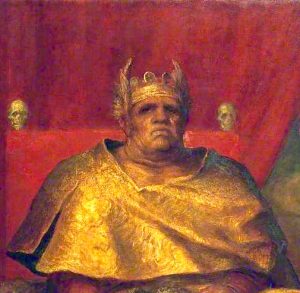
Some people have been asking me about the picture in my last post. It is worth a closer look. Its message is, sadly, timeless, but particularly relevant to our troubled age. In the 1880s, the artist, G. F. Watts (1817–1904), was a senior figure in the London art world and known as ‘England’s Michelangelo’. He was an intellectual whose work pioneered symbolism; a deep thinker who painted ideas. Oscar Wilde called him ‘a great originative and imaginative genius’.1 Barak Obama was particularly drawn to Watt’s Hope which, I read somewhere, hung in the White House, and Watts was an inspiration to Martin Luther King. (This Guardian article is a good introduction to Watts.)
The full title of this work is Mammon—dedicated to his worshippers and the heavy, gilded, obscene demonic deity dominating this image is ‘massive’, that is, weighed down by gold whose gravitational pull binds him to the earth. His gouty leg (more visible in the artist’s line drawing of the subject) and unfeeling, swollen arm bear down on lifeless figures—fragile humanity, the imago Dei crushed by the weight of unfeeling avarice. Continue reading “Mammon—dedicated to his worshippers”
